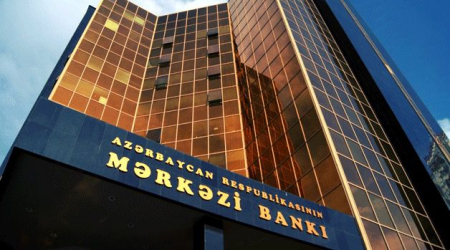ARTİCLE
 Bölmə: Araşdırma ›
,
Bölmə: Araşdırma ›
,
Tarix: 22:46 09.04.2024
Topic: The role of central banks in financial stability
Student: Akber Guliyev
PREFACE
We know that the provision of financial stability in the country is mainly regulated by the Central Bank. Thus, one of the main functions of the Central Bank is to ensure financial stability. In this regard, the role of the Central Bank in the successful implementation and conclusion of the state's financial policy is great.
In this article, we will talk about what the Central Bank is, its history, the main goals facing it, the tools for ensuring finance, and the activities of the Central Bank in Azerbaijan.
Keywords: Central Bank, monetary policy, financial stability.
Plan
Preface
Introduction
Historical perspective of the Central banks
Objective of the Central banks
Activities of the Central Bank of the Republic of Azerbaijan in the field of financila stability
Conclusion
Reference list
INTRODUCTION
Over time, the increase in the functions of money and its effectiveness in economic life paved the way for the creation of central banks. The Central Bank, which is the regulator of the monetary structure and banking system, also appears as the bank of banks.
The Central Bank is an institution that manages the currency of a certain country and controls its money supply, that is, the amount of money in circulation. The Central Bank, which is the regulator of the monetary structure and banking system, also appears as the bank of banks. The main purpose of many central banks is price stability. It is not accidential that it is known that the main function of the Central Bank is to ensure financial stability.
One of the main tools of central banks is the determination of the “value of money” as part of monetary policy. An ordinary citizen cannot open a bank account in his name at the central bank or take a loan from the bank. That is why a central bank is not a commercial bank.
The Central Bank plays the role of the main bank for commercial banks and influences the flow of money and credit in the finance in this way to achieve price stability.
Commercial banks may face a “liquidity” problem, because they can provide long-term loans in return for short-term deposits. It is a situation where they have the money to pay off the debt but don’t have the ability to turn it into cash quickly. It is where the central bank can act as a “lender of last resort”. It plays a main role for keeping the financial system stable.
While commercial banks create fiat money and increase the money supply by accepting deposits and extending loans, central banks control the volume of loans extended by banks and thus the fiat money supply through various means. Moreover, the authority to issue the money in circulation is in the hands of the Central Bank. As a result, banks are institutions that trade in credit and central banks are institutions responsible for implementing monetary policies.
HISTORICAL PERSPECTIVE OF CENTRAL BANKS
In the past, there have been different practices regarding the duties undertaken by central banks. When central banking is examined from a historical perspective, the following periods come to the fore. According to the generally accepted division in the world, the development history of central banking consists of 5 stages:
1) The stage of formation of central banks (1668-1873);
2) The golden standart period of central banking development (1873-1914);
3) The period of wars and crises (1914-1945);
4) Bretton Woods period in central banking (1945-1971);
5) Independent Central Banking (1971-present).
Throughout history, especially during times of war, public financing has come to the fore, but the main task of central banks has been to protect the internal and external value of money. Protecting the internal value of money means protecting and trying to increase purchasing power in domestic markets, while protecting its external value means protecting its value against foreign currencies. The first central bank in the real sense is the Bank of Sweden, established in 1668. Later, central banks of other countries began to emerge. For example, Central Bank of England was established England, “Banque de France” was established in France in 1800, “Bank of Finland” in Finland in 1811, and “Danmark Nationalbank” in Denmark in 1818 and etc.
With the introduction of the gold standard, central banks began printing money only in exchange for gold reserves. In this way, foreign currency trading and monetary policy tools began to be used between states. The main tool used to achieve the goal was the control of interest rates. Central banks have used gold reserves to intervene in order to control interest rates, and have tried to prevent interest rate increases by buying gold and interest rate increases by selling gold. During this period, central banks acted independently of governments, withdrawing from commercial competition and played a greater role as banks' banks.
The two world wars between 1914 and 1945 deeply affected economic policies and central banking. The outbreak of war in August 1914 created an unexpected shock in the financial markets. What was necessary in this period was that the central banks provide the liquidity required to overcome the panic. Central banks initially provided the necessary liquidity by adhering to the gold standard. However, with the war expenditures, gold began to be used mainly to finance the balance of payments and, in this context, began to be removed from circulation. Again, during the war, central banks began to provide intensive loans to the government. It is no longer possible to provide the created money in exchange for gold. In this context, central banks began to print paper money as a legal means of exchange that was not convertible and was the obligation of either the government or the central bank. During the war, the liberal economic approach was abandoned and the practice of controlling capital movements began to be widely used.
In 1944, the Bretton Woods monetary system, centered on the USA, was established. With this system, the monetary system, which until then had been tied to gold and influenced by sterling, became dependent on the dollar. In the system, while all countries determined the value of their currencies according to the US dollar, the dollar found its value relative to gold, and the US Central Bank assumed the role of the world's Central Bank by undertaking to give gold in exchange for the dollars they would supply to the Central Banks of other countries. The dollar devaluations of 1971 and 1973 put an end to the Bretton Woods system, and the dollar lost its dominance against the strengthening national currencies of Western Europe and Japan, but the multinational institutions created by the system continued to increase their effectiveness in the international arena. These multinational institutions created by the Bretton Woods system are the International Monetary Fund and International Bank for Reconstruction and Development. The IMF, which was established to meet the short-term financing need for balance of payments deficits, and the IBRD, which was established to provide the long-term financing needed for infrastructure investments for development, are the first examples of multinational financial institutions. In the 1960s, commercial banks of industrialized countries such as England, France, Japan, Germany, the Netherlands, Belgium, Switzerland and Sweden began to compete with US banks in international markets. As a result of increasing competition in international markets, the variety of vehicles and services in the markets has begun to increase.
With the collapse of the Bretton Woods system and the transition to the floating exchange rate regime, significant changes occurred in the monetary policy strategies of central banks and the tools they used, and the seeds of today's modern central banking understanding were laid.
OBJECTIVE OF CENTRAL BANKS
The main purpose of a central bank is to ensure financial stability. Depending on the country, central banks might have other objectives such as unemployment, controlling inflation, interest rates, or exchange rates. But all these objectives are in line with the main objective of ensuring financial stability.
Central banks have the monopoly of issuing notes, and these notes issued by central banks act as legal tender of money. The money put in circulation must be monitored by central bank to ensure that there is just the right amount in circulation.
All commercial banks are obliged to report to the Central Bank regarding the fulfillment of their obligations. These reports play an important role in making financial decisions. The central bank can affect the activities of commercial banks through its monetary policies.
The central bank advises the government on economic and monetary matters such as inflation and deficit financing. The central bank also provides short-term loans to the government.
The control of credit is realized through the use of the financial policy. The central bank controls the credit creation power of marketable banks to check inflationary and deflationary pressures on the economy.
At the same time, as we know, one of the main goals of the central bank is to achieve financial stability. Central banks use monetary policy to achieve price stability, which means that inflation is low and stable. Central banks conduct monetary policy by adjusting the supply of money, usually by buying or selling securities in the open market. They are directly proportional.
ACTIVITIES OF THE CENTRAL BANK OF THE REPUBLIC OF AZERBAIJAN IN THE FIELD OF FINANCIAL STABILITY
The role of the Central Bank in the success of the financial policy of the Republic of Azerbaijan is great. As a result of the efficient operation of the Central Bank, despite being independent for 30 years, the Republic of Azerbaijan has made more progress in the financial field than other post-Soviet countries.
Article 1 of the Law of the Republic of Azerbaijan "On the Central Bank" stipulates that the Central Bank of the Republic of Azerbaijan is the central bank of the Republic of Azerbaijan. Article 4 of that Law states that: "The main goal of the Central Bank's activity is to ensure price stability within its powers established by this Law." Without prejudice to its main purpose, the Central Bank ensures financial stability within the powers established by the laws regulating the financial markets. Taking profit is not the main goal of the Central Bank."
The strategic goal of the monetary policy is to achieve economic growth characterized by full employment, price stability, balance of the state budget and balance of payments. The tactical objective refers to the duties of monetary and credit institutions to conduct consistent operations in the open market. The intermediate goal expresses the tasks of regulating economic changes in a certain period of time. Intermediate goals include the nominal volume of production, interest rate, growth rate of money supply, price level. The ultimate goal is the degree of influence of monetary and credit policy on the production process, and intermediate goals are involved as a regulatory direction for the balance of demand and supply in the monetary and credit and financial spheres. Depending on the tactical, intermediate and final goals, there are two methods of implementing monetary policy:
One-tier policy.
Two-tier policy.
A one-step policy is a direct policy to achieve the ultimate goal. In the two-level policy, we are talking about reaching the final goal through intermediate goals.
The Central Bank determines the discount rate and interest rates for its operations. When determining the discount rate, the Central Bank takes into account the current macroeconomic situation in the country and the state of the financial market. The Central Bank determines the interest rates for its operations by determining the interest rates for its open market, refinancing and deposit operations, taking into account the liquidity situation of the money market, or on the basis of demand and supply in auctions. The Central Bank publishes the discount rate it determines and the interest rates for its operations.
In order to implement monetary policy, the Central Bank refinances credit institutions. At this time, loans should be secured by government securities, guarantees and guarantees of the government and other reliable issuers, foreign currency, gold, precious metals in various forms, and other assets. The form, rules and conditions of refinancing are determined by the Board of Directors of the Central Bank. Loans are granted only to the head offices of credit organizations. The Central Bank attracts deposits from credit institutions and places deposits in them under the conditions determined by it and on the basis of mutual agreement.
CONCLUSION
In this article, we tried to provide information about the role of Central Banks in financial stability both in relation to the generally defined position and the Republic of Azerbaijan. To form a comprehensive idea about the role of central banks in financial stability, it is necessary to pay attention to the history of the development of central banks, the functions of central banks, as well as the meaning of financial stability. What is the financial stability? Financial stability is the basis of a strong and sustainable financial system. There are many different ways to define financial stability. According to most financial institutions, the absence of system-wide episodes of crisis is the basis of financial stability. The Central Bank plays the role of the main bank for commercial banks and influences the flow of money and credit in the finance in this way to achieve price stability. The financial system always tends to create instability and spread this instability. Therefore, the public sphere always bears responsibility for ensuring financial stability. Central Banks also bear this responsibility because they have a monopoly on the currency and their main target is price stability.
REFERENCE LIST
Law of the Republic of Azerbaijan "On the Central Bank".
Hilmi GULAY. Merkezi Bankin Finansal Mimarideki Rolu ve Turkiye. 2009.
Dr. Burak Darici. Finansal İstikrar ve Finansal İstikrara Yonelik Kamusal Sorumluluk Cherchevesinde Para Politikasi: Turkiye Analizi.
https://www.investopedia.com/terms/c/centralbank.asp
https://www.ecb.europa.eu/ecb/educational/explainers/tell-me/html/what-is-a-central-bank.en.html
https://www.imf.org/en/About/Factsheets/Sheets/2023/monetary-policy-and-central-banking#:~:text=Central%20banks%20use%20monetary%20policy,economies%20set%20explicit%20inflation%20targets.
https://analystprep.com/cfa-level-1-exam/economics/describe-roles-objectives-central-banks/
Quliyev Əkbər









